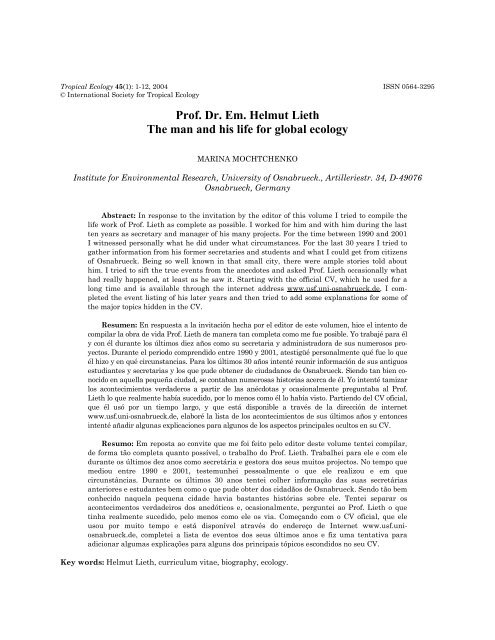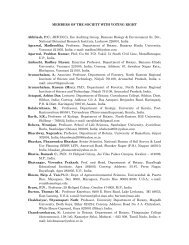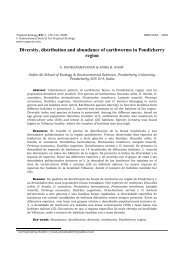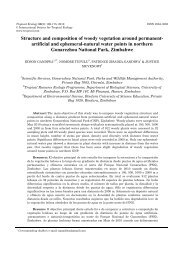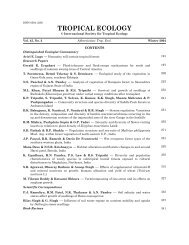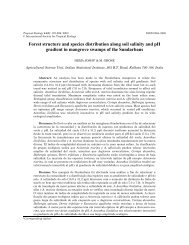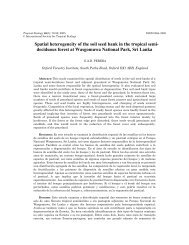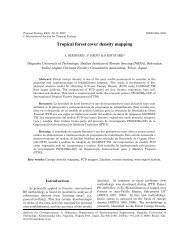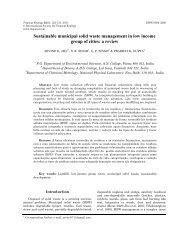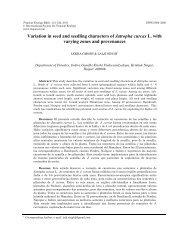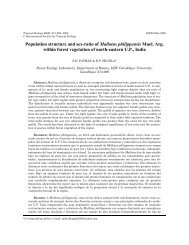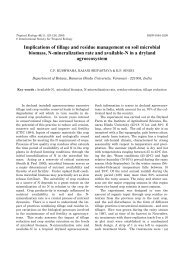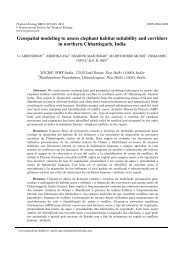Prof. Dr. Em. Helmut Lieth The man and his life for global ecology
Prof. Dr. Em. Helmut Lieth The man and his life for global ecology
Prof. Dr. Em. Helmut Lieth The man and his life for global ecology
- TAGS
- helmut
- lieth
- global
- ecology
- tropecol.com
You also want an ePaper? Increase the reach of your titles
YUMPU automatically turns print PDFs into web optimized ePapers that Google loves.
MOCHTCHENKO 1<br />
Tropical Ecology 45(1): 1-12, 2004 ISSN 0564-3295<br />
© International Society <strong>for</strong> Tropical Ecology<br />
<strong>Prof</strong>. <strong>Dr</strong>. <strong>Em</strong>. <strong>Helmut</strong> <strong>Lieth</strong><br />
<strong>The</strong> <strong>man</strong> <strong>and</strong> <strong>his</strong> <strong>life</strong> <strong>for</strong> <strong>global</strong> <strong>ecology</strong><br />
MARINA MOCHTCHENKO<br />
Institute <strong>for</strong> Environmental Research, University of Osnabrueck., Artilleriestr. 34, D-49076<br />
Osnabrueck, Ger<strong>man</strong>y<br />
Abstract: In response to the invitation by the editor of t<strong>his</strong> volume I tried to compile the<br />
<strong>life</strong> work of <strong>Prof</strong>. <strong>Lieth</strong> as complete as possible. I worked <strong>for</strong> him <strong>and</strong> with him during the last<br />
ten years as secretary <strong>and</strong> <strong>man</strong>ager of <strong>his</strong> <strong>man</strong>y projects. For the time between 1990 <strong>and</strong> 2001<br />
I witnessed personally what he did under what circumstances. For the last 30 years I tried to<br />
gather in<strong>for</strong>mation from <strong>his</strong> <strong>for</strong>mer secretaries <strong>and</strong> students <strong>and</strong> what I could get from citizens<br />
of Osnabrueck. Being so well known in that small city, there were ample stories told about<br />
him. I tried to sift the true events from the anecdotes <strong>and</strong> asked <strong>Prof</strong>. <strong>Lieth</strong> occasionally what<br />
had really happened, at least as he saw it. Starting with the official CV, which he used <strong>for</strong> a<br />
long time <strong>and</strong> is available through the internet address www.usf.uni-osnabrueck.de, I completed<br />
the event listing of <strong>his</strong> later years <strong>and</strong> then tried to add some explanations <strong>for</strong> some of<br />
the major topics hidden in the CV.<br />
Resumen: En respuesta a la invitación hecha por el editor de este volumen, hice el intento de<br />
compilar la obra de vida <strong>Prof</strong>. <strong>Lieth</strong> de <strong>man</strong>era tan completa como me fue posible. Yo trabajé para él<br />
y con él durante los últimos diez años como su secretaria y administradora de sus numerosos proyectos.<br />
Durante el periodo comprendido entre 1990 y 2001, atestigüé personalmente qué fue lo que<br />
él hizo y en qué circunstancias. Para los últimos 30 años intenté reunir in<strong>for</strong>mación de sus antiguos<br />
estudiantes y secretarias y los que pude obtener de ciudadanos de Osnabrueck. Siendo tan bien conocido<br />
en aquella pequeña ciudad, se contaban numerosas <strong>his</strong>torias acerca de él. Yo intenté tamizar<br />
los acontecimientos verdaderos a partir de las anécdotas y ocasionalmente preguntaba al <strong>Prof</strong>.<br />
<strong>Lieth</strong> lo que realmente había sucedido, por lo menos como él lo había visto. Partiendo del CV oficial,<br />
que él usó por un tiempo largo, y que está disponible a través de la dirección de internet<br />
www.usf.uni-osnabrueck.de, elaboré la lista de los acontecimientos de sus últimos años y entonces<br />
intenté añadir algunas explicaciones para algunos de los aspectos principales ocultos en su CV.<br />
Resumo: <strong>Em</strong> reposta ao convite que me foi feito pelo editor deste volume tentei compilar,<br />
de <strong>for</strong>ma tão completa quanto possível, o trabalho do <strong>Prof</strong>. <strong>Lieth</strong>. Trabalhei para ele e com ele<br />
durante os últimos dez anos como secretária e gestora dos seus muitos projectos. No tempo que<br />
mediou entre 1990 e 2001, testemunhei pessoalmente o que ele realizou e em que<br />
circunstâncias. Durante os últimos 30 anos tentei colher in<strong>for</strong>mação das suas secretárias<br />
anteriores e estudantes bem como o que pude obter dos cidadãos de Osnabrueck. Sendo tão bem<br />
conhecido naquela pequena cidade havia bastantes <strong>his</strong>tórias sobre ele. Tentei separar os<br />
acontecimentos verdadeiros dos anedóticos e, ocasionalmente, perguntei ao <strong>Prof</strong>. <strong>Lieth</strong> o que<br />
tinha realmente sucedido, pelo menos como ele os via. Começ<strong>and</strong>o com o CV oficial, que ele<br />
usou por muito tempo e está disponível através do endereço de Internet www.usf.uniosnabrueck.de,<br />
completei a lista de eventos dos seus últimos anos e fiz uma tentativa para<br />
adicionar algumas explicações para alguns dos principais tópicos escondidos no seu CV.<br />
Key words: <strong>Helmut</strong> <strong>Lieth</strong>, curriculum vitae, biography, <strong>ecology</strong>.
2 PROF. LIETH AND GLOBAL ECOLOGY<br />
Introduction<br />
As the last <strong>man</strong>ager <strong>and</strong> personal secretary <strong>for</strong><br />
<strong>Prof</strong>. <strong>Dr</strong>. <strong>Helmut</strong> <strong>Lieth</strong> I have the privilege to<br />
report about <strong>his</strong> <strong>life</strong> <strong>his</strong>tory. <strong>Lieth</strong>'s family can be<br />
divided into three main sections from 1950 to 1966<br />
where they were living basically in Ger<strong>man</strong>y<br />
although at different places, the time in North<br />
Carolina between 1966-1977 <strong>and</strong> the time from<br />
1977 onward where <strong>Dr</strong>. <strong>Lieth</strong> <strong>and</strong> <strong>his</strong> wife lived in<br />
Ger<strong>man</strong>y in two places, their native Kuerten <strong>and</strong><br />
the professional site Osnabrueck where <strong>Dr</strong>. <strong>Lieth</strong><br />
held the position of <strong>Prof</strong>. of Ecology <strong>and</strong> was<br />
Director of independent scientific projects of<br />
various kinds. For one of these projects,<br />
Environmental Research on Lake Baikal <strong>and</strong> Its<br />
Surroundings, he hired me as secretary/<strong>man</strong>ager/<br />
translator.<br />
<strong>Prof</strong>. <strong>Lieth</strong> still keeps a normal <strong>life</strong> as a family<br />
<strong>man</strong> who, at the age of 76, still lives in a country<br />
home (where he was actually born) <strong>and</strong> keeps the<br />
place neat, rakes the leaves of <strong>his</strong> beloved, over<br />
150 years old Linden tree, keeps the garden in<br />
shape so that <strong>his</strong> wife, age 80 can plant some<br />
vegetables, <strong>and</strong> where he himself makes repairs on<br />
walls <strong>and</strong> roofs of their house using skills which an<br />
ordinary crafts<strong>man</strong> of today would shake <strong>his</strong> head.<br />
At present he still has projects in the Arabian Gulf<br />
region, in Usbekistan <strong>and</strong> in Russia. All are<br />
intended as contributions to either convert deserts<br />
into arable l<strong>and</strong> or to improve regional<br />
environmental conditions.<br />
Some Notes about the Life of a<br />
Scientist<br />
<strong>Dr</strong>. <strong>Lieth</strong> obtained ecological experience as a<br />
country boy from <strong>his</strong> gr<strong>and</strong>father who took him<br />
along ploughing the field, mowing grass <strong>and</strong><br />
hearding the cattle. His gr<strong>and</strong>father taught him<br />
the difference between heavy <strong>and</strong> light soil or<br />
between basic soil <strong>and</strong> acid soil or flowers that are<br />
found only in calcareous woodl<strong>and</strong>.<br />
His father Heinrich, who had been wounded<br />
during World War I, could not continue farm<br />
work <strong>and</strong> moved as revenue officer to<br />
Gotha/Thueringen when <strong>Dr</strong>. <strong>Lieth</strong> was of age 7.<br />
From <strong>his</strong> school education <strong>Prof</strong>. <strong>Lieth</strong> remembered<br />
3 teachers who gave him basic skills; one<br />
how to spell correctly high Ger<strong>man</strong>, one how to<br />
organise a paper, <strong>and</strong> one how to calculate. When<br />
he was 14 he moved with <strong>his</strong> family closer to their<br />
native Rhinel<strong>and</strong>. <strong>The</strong> new place was Gelsenkirchen,<br />
in the very heart of the world famous<br />
"Ruhr Revier" where the combination of coal mining,<br />
chemical industry <strong>and</strong> steel making caused<br />
environmental problems everywhere in water, air<br />
<strong>and</strong> l<strong>and</strong>. <strong>The</strong> problems were discussed in school<br />
with all their ramifications: Health, Social, Nature<br />
<strong>and</strong> Politics. "It was in t<strong>his</strong> environment<br />
where he decided to devote <strong>his</strong> <strong>life</strong> to science, to<br />
environmental biology <strong>and</strong> to what was later on<br />
called <strong>global</strong> <strong>ecology</strong>.<br />
<strong>The</strong> young boy overcame year by year the set<br />
backs of new schools <strong>and</strong> language environments<br />
<strong>and</strong> gradually advanced towards the upper half of<br />
the class, when World War II broke out <strong>and</strong> by<br />
1943 he <strong>and</strong> <strong>his</strong> classmates were drafted <strong>for</strong><br />
military service. He volunteered <strong>for</strong> the navy, a<br />
choice which had again relevant impact upon <strong>his</strong><br />
later choice of studies. He volunteered <strong>for</strong> a<br />
position as communication specialist <strong>and</strong> learned<br />
much physics including wireless transmission <strong>and</strong><br />
electronics. When the computer age arrived a<br />
decade later, the military service had primed him<br />
already <strong>and</strong> radar images under the Ger<strong>man</strong> name<br />
"Funkmess" were nothing new <strong>for</strong> him.<br />
During <strong>his</strong> University education directly after<br />
World War II he came in contact with <strong>Prof</strong>.<br />
Noddack, the then well known geochemist<br />
(discoverer of Rhenium) <strong>and</strong> <strong>his</strong> "doctor father"<br />
<strong>Prof</strong>. Knapp, who guided him in organising field<br />
work.<br />
He was rather poor at that time; <strong>his</strong> father had<br />
died <strong>and</strong> <strong>his</strong> mother could not af<strong>for</strong>d to pay <strong>for</strong> <strong>his</strong><br />
education, <strong>and</strong> he had to work <strong>for</strong> it. He repaired<br />
motorcycles, installed electricity in country houses<br />
<strong>and</strong> most prominent of all he started, together<br />
with <strong>his</strong> then fiance, a knitting job. <strong>The</strong>y bought a<br />
h<strong>and</strong> knitting machine <strong>and</strong> offered sweaters <strong>and</strong><br />
jackets knitted from home spun wool to the<br />
neighbours. During t<strong>his</strong> time they married.<br />
After obtaining the Ph.D. degree <strong>Prof</strong>. <strong>Lieth</strong><br />
stayed <strong>for</strong> two more years as assistant in the<br />
Botany Department of the University of Cologne.<br />
1955 - 1966 <strong>The</strong> Hohenheim Period<br />
Towards the end of 1955 <strong>Prof</strong>. <strong>Lieth</strong> left the<br />
University of Cologne <strong>and</strong> went to Stuttgart-<br />
Hohenheim, the famous Agricultural University<br />
where <strong>Prof</strong>. Heinrich Walter taught botany with<br />
<strong>ecology</strong> as the main focus. It was here where <strong>Prof</strong>.<br />
<strong>Lieth</strong> laid the foundation <strong>for</strong> <strong>his</strong> later research.
He undertook several projects simultaneously,<br />
began to write research proposals <strong>and</strong> soon received<br />
first grants much to the pleasant surprise<br />
of <strong>his</strong> professor who at that time had begun to<br />
write <strong>his</strong> world famous treaties Vegetation of the<br />
World. It took about five years of research on<br />
light influence upon plant growth <strong>and</strong> development<br />
until <strong>Prof</strong>. <strong>Lieth</strong> presented <strong>his</strong> paper about<br />
the light compensation point in l<strong>and</strong> plants, the<br />
paper with which he obtained the teaching certificate<br />
in Universities. T<strong>his</strong> was in 1959/60. Simultaneously<br />
he worked with <strong>Prof</strong>. Walter on the<br />
compilation of the famous "Climate Diagram<br />
World Atlas". <strong>The</strong> first part of t<strong>his</strong> atlas made<br />
him well known in Europe.<br />
<strong>Prof</strong>. <strong>Lieth</strong> went to Montreal/Canada from May<br />
1960 - May 1961 to work in the Université de<br />
Montreal with <strong>Prof</strong>. Dansereau whom he had met<br />
in 1958 during the International Biological Congress.<br />
T<strong>his</strong> year marked the change in <strong>Prof</strong>. <strong>Lieth</strong>'s<br />
<strong>life</strong> from a mainly European scientist to a <strong>global</strong>ly<br />
oriented Ecologist.<br />
Entering International Ecology<br />
It must have been in Stuttgart-Hohenheim<br />
when <strong>Prof</strong>. <strong>Lieth</strong> developed <strong>his</strong> interest in <strong>global</strong><br />
<strong>ecology</strong>. His work on light compensation point in<br />
plants <strong>and</strong> competition among grassl<strong>and</strong> species<br />
were discussed in several European countries <strong>and</strong><br />
when he started to work on net primary productivity<br />
he succeeded in organising <strong>his</strong> first international<br />
symposium. Backed by <strong>Prof</strong>. Walter he<br />
brought <strong>man</strong>y well known scientists to the meeting<br />
<strong>and</strong> compiled their papers into a book. Up to now<br />
he must have authored <strong>and</strong> published more than<br />
60 books <strong>and</strong> can still not resist to publish <strong>and</strong><br />
edit. During the time in Hohenheim <strong>Prof</strong>. <strong>Lieth</strong><br />
was also called <strong>for</strong> <strong>for</strong>eign aid projects by several<br />
ministries. T<strong>his</strong> brought him several times to<br />
South America <strong>and</strong> to the first trip around the<br />
world in 1963. He was asked to check on ecological<br />
problems with Hevea brasiliensis, the main rubber<br />
tree species in Malaysia, Central America <strong>and</strong><br />
tropical South America. At the same time appeared<br />
the Climate Diagram World Atlas which<br />
made him known in vegetation science all over the<br />
world. Out of the 8000 diagrams in the atlas, he<br />
probably drew 7000 rough drafts in the course of<br />
six or eight years. Much of t<strong>his</strong> work was done in<br />
the research laboratory of <strong>Prof</strong>. C.W. Thornthwaite<br />
in New Jersey.<br />
MOCHTCHENKO 3<br />
International Activities<br />
Conferences<br />
Besides the <strong>man</strong>y events <strong>Prof</strong>. <strong>Lieth</strong> organised<br />
himself, he also attended numerous scientific<br />
meetings, delivered invited lectures <strong>and</strong> seminars<br />
in Universities all over the world <strong>and</strong> gave<br />
speeches to the public. He appeared on successful<br />
Radio <strong>and</strong> TV programs at home <strong>and</strong> abroad.<br />
One of the major events was <strong>his</strong> presentation<br />
of the "Miami model", which he developed together<br />
with Elgene Box: <strong>The</strong> “Net primary productivity of<br />
the biosphere predicted from annual temperature<br />
<strong>and</strong> precipitation averages”, first presented at the<br />
AIBS meeting in Miami <strong>and</strong> then during the 1st Intecol conference in the Hague/Netherl<strong>and</strong>s.<br />
Within one year t<strong>his</strong> paper was absorbed by the<br />
ecological community of the world, appearing in<br />
several languages. <strong>The</strong> attraction at that time was<br />
the combination of a correlation model between<br />
climatic parameters <strong>and</strong> allowed the rough quantity<br />
calculation. <strong>The</strong> mapping routine was a <strong>for</strong>erunner<br />
of the modern GIS.<br />
Publication Activities<br />
He accepted editing journals <strong>and</strong> book series,<br />
initiated new ones <strong>and</strong> h<strong>and</strong>ed the job over to<br />
other colleagues when he saw that others might do<br />
a better job at it.<br />
While t<strong>his</strong> biography is being published he is<br />
still an active writer <strong>and</strong> editor <strong>and</strong> I hope that I<br />
can assist him in that activity <strong>for</strong> <strong>man</strong>y more<br />
years.<br />
<strong>The</strong> Time in Chapel Hill/NC/USA<br />
1966 -1977<br />
During the time in Hohenheim <strong>Prof</strong>. <strong>Lieth</strong> had<br />
visited Canada twice. For a period of one year in<br />
60/61 he travelled with <strong>his</strong> family <strong>and</strong> met so<br />
<strong>man</strong>y friends in North America that he <strong>and</strong> <strong>his</strong><br />
wife were persuaded to leave Europe <strong>and</strong> move to<br />
America in case a suitable place were offered. In<br />
1966 a position was offered to an ecologist in the<br />
Botany Department of the University of North<br />
Carolina at Chapel Hill, a campus that just had<br />
initiated a new department "Computer Science"<br />
based on an IBM 360. <strong>Dr</strong>. <strong>Lieth</strong> accepted the posi-
4 PROF. LIETH AND GLOBAL ECOLOGY<br />
tion <strong>and</strong> was the first biologist in Chapel Hill to<br />
use the computer <strong>for</strong> <strong>his</strong> research. <strong>The</strong> data were<br />
punched on hollerith cards. It took few semesters<br />
<strong>and</strong> a group of students came to. Within a few<br />
years the Chapel Hill plant <strong>ecology</strong> group became<br />
well known <strong>for</strong> their output regarding phenology<br />
<strong>and</strong> primary productivity. Within two years they<br />
used about 1 ton of hollerith cards.<br />
He was sent as US IBP representative to <strong>man</strong>y<br />
international seminars <strong>and</strong> workshops where he<br />
could present the latest computer outputs of <strong>his</strong><br />
group in Chapel Hill. <strong>The</strong> majority were new thematic<br />
maps which were made with the SYMAP<br />
program which allowed quantitative evaluation of<br />
geographic maps.<br />
During t<strong>his</strong> time all four children of the <strong>Lieth</strong>'s<br />
family went through college <strong>and</strong> entered one by<br />
one Universities, leaving home <strong>and</strong> their mother<br />
lonesome. In 1973/74 <strong>Dr</strong>. <strong>Lieth</strong> had the possibility<br />
of sabbatical leave, which he took, as a visiting<br />
scientist in the then very active KFA<br />
Jülich/Ger<strong>man</strong>y, close enough to <strong>his</strong> old home<br />
town where <strong>his</strong> wife could meet with her brothers<br />
<strong>and</strong> sisters. It was a very active time during which<br />
a co-operative program was developed, between<br />
UNC <strong>and</strong> KFA, with student <strong>and</strong> faculty exchanges<br />
involving unusual research topics including<br />
multielement analyses <strong>and</strong> biophysical topics.<br />
<strong>Prof</strong>. <strong>Lieth</strong> decided to try a return to Ger<strong>man</strong>y<br />
if a reasonable University position could be<br />
found.<br />
A new position was open at a newly founded<br />
biology department at the University of Osnabrueck<br />
<strong>and</strong> took the job in 1977 <strong>and</strong> travelled<br />
<strong>for</strong> the next three years between Europe <strong>and</strong><br />
America finishing up old students in Chapel Hill<br />
<strong>and</strong> attending to new ones in Osnabrueck.<br />
<strong>The</strong> Time in Osnabrueck<br />
1977-2001<br />
<strong>The</strong> time in Osnbarueck began very turbulently.<br />
<strong>The</strong> Ger<strong>man</strong> students had started unrest<br />
since 1968 often interrupting classes <strong>and</strong> curricula.<br />
However, a group of them gathered around<br />
him <strong>and</strong> helped him to initiate a new nucleus of<br />
computer oriented studies.<br />
<strong>Prof</strong>. <strong>Lieth</strong> was involved in the planning <strong>and</strong><br />
constructing of the new biology building which included<br />
a new botanical garden. In the meantime<br />
t<strong>his</strong> garden had developed into a fine research cen-<br />
ter <strong>and</strong> a major tourist attraction <strong>for</strong> the city of<br />
Osnabrueck. <strong>Prof</strong>. <strong>Lieth</strong>’s colleagues had put<br />
enormous ef<strong>for</strong>t into the development of the garden<br />
which, by its natural condition, was a lime<br />
stone quarry be<strong>for</strong>e, combining interesting geological<br />
features with a very attractive collection of<br />
plants <strong>and</strong> a very effective teaching program.<br />
When <strong>his</strong> botanist colleague took over the work<br />
<strong>for</strong> the botanical garden, <strong>Dr</strong>. <strong>Lieth</strong> concentrated on<br />
the development of an interdisciplinary study<br />
group <strong>for</strong> a computer based environmental systems<br />
research <strong>for</strong> which he received help from <strong>his</strong> colleagues<br />
<strong>Prof</strong>. Müller from sociology <strong>and</strong> <strong>Prof</strong>. Witte<br />
from economics. <strong>The</strong> three together developed a<br />
prototype of multidisciplinary environmental research<br />
<strong>and</strong> teaching. <strong>The</strong>ir major project concerned<br />
the impact of battery farming upon the groundwater<br />
in NW Lower Saxony a project that brought the<br />
University a large amount of research funds from<br />
several funding agencies, <strong>and</strong> brought the three<br />
directors of the study lots of problems with politicians<br />
<strong>and</strong> regional administration because of the<br />
modelling results.<br />
Out of t<strong>his</strong> project developed the Institute of<br />
Environmental Systems Research (IES) which is<br />
steadily increasing in size <strong>and</strong> importance under<br />
its new director <strong>Prof</strong>. <strong>Dr</strong>. Matthies.<br />
<strong>Prof</strong>. <strong>Lieth</strong> worked also on elemental analysis in<br />
ecosystems, phenology <strong>and</strong> nature protection. During<br />
twenty years he went to the UAE <strong>and</strong> developed<br />
saline irrigation systems in deserts with halophytes<br />
<strong>and</strong> stunned <strong>his</strong> colleagues by successfully planting<br />
<strong>man</strong>groves in the desert. He did t<strong>his</strong> work together<br />
with <strong>his</strong> youngest son Armin, who after six years of<br />
the work there went home to continue <strong>his</strong> l<strong>and</strong>scaping<br />
business in the environs of Chapel Hill.<br />
In 1990 <strong>Prof</strong>. <strong>Lieth</strong> undertook a field trip with<br />
60 students from Osnabrueck to Yokohama <strong>for</strong> the<br />
Intecol conference across Europe, Russia <strong>and</strong> Siberia.<br />
He stayed <strong>for</strong> several weeks on the shores of<br />
Lake Baikal <strong>and</strong> decided to put major ef<strong>for</strong>t into<br />
ecological investigations around Lake Baikal. It<br />
was in 1991 when I first met <strong>Prof</strong>. <strong>Lieth</strong> during a<br />
field trip with students to Olchon Isl<strong>and</strong>. During<br />
t<strong>his</strong> trip he asked me to join him <strong>for</strong> six months.<br />
He needed a translator to Russian <strong>and</strong> there I remain<br />
until today. He called me <strong>his</strong> "Russian voice".<br />
Together we spent days <strong>and</strong> weeks of negotiations<br />
in administrative offices in Moscow, Novosibirsk<br />
<strong>and</strong> Irkutsk. It was a very turbulent time until<br />
conditions in Irkutsk changed <strong>and</strong> the European
Community funded <strong>his</strong> project <strong>for</strong> Sustainable<br />
Utilisation of Halophytes.<br />
<strong>The</strong> multielement analysis, which <strong>Prof</strong>. <strong>Lieth</strong><br />
had learned through contacts with colleagues in<br />
the physics department of Duke University <strong>and</strong><br />
North Carolina State University <strong>and</strong> in greater<br />
detail at the Nuclear Research Institute in Juelich,<br />
encouraged him to analyse complete chemical element<br />
circulations through the biota. He postulated<br />
that t<strong>his</strong> might have the same importance <strong>for</strong> the<br />
minor elements as it had <strong>for</strong> the major elements<br />
<strong>and</strong> the comparative frequency analysis might<br />
bring a better underst<strong>and</strong>ing about the ecological<br />
importance of all chemical elements in ecosystems.<br />
For t<strong>his</strong> work he found an excellent student,<br />
now <strong>Prof</strong>. Markert at the IHI Zittau, who developed<br />
with <strong>Dr</strong>. <strong>Lieth</strong> the element cadasters in ecosystems<br />
<strong>and</strong> from <strong>his</strong> own work the biological system<br />
of chemical elements.<br />
<strong>The</strong> President of International<br />
Scientific Societies<br />
During <strong>his</strong> time in Chapel Hill, <strong>Prof</strong>. <strong>Lieth</strong> was<br />
called to become a member of a group "Ecosystems<br />
Analysis" which was generated through the<br />
American involvement in the IBP, International<br />
Biological Program. T<strong>his</strong> group undertook the task<br />
to model live major biomes of North America. <strong>Dr</strong>.<br />
<strong>Lieth</strong> was asked to first chair the Eastern Deciduous<br />
Forest Biome <strong>and</strong> later to chair the Tropical<br />
Forest Biome. It was within t<strong>his</strong> group's work<br />
where <strong>Prof</strong>. <strong>Lieth</strong> developed the "Miami Model".<br />
On <strong>his</strong> return to Ger<strong>man</strong>y, the development of<br />
the University of Osnabrueck certainly became<br />
noticed by colleagues in other European Universities<br />
<strong>and</strong> <strong>Prof</strong>. <strong>Lieth</strong> found himself elected to influential<br />
positions in government advisory committees,<br />
academic society presidencies <strong>and</strong> invitations<br />
<strong>for</strong> international co-operations.<br />
He apparently revived the slackening International<br />
Society of Biometeorology (ISB) <strong>and</strong> the International<br />
Society of Ecology (INTECOL). He became<br />
the president of ISB <strong>and</strong> of the Society of<br />
Tropical Ecology as well as the editor of the H<strong>and</strong>book<br />
<strong>for</strong> Vegetation Science.<br />
<strong>Prof</strong>. <strong>Lieth</strong> <strong>and</strong> the Society of<br />
Tropical Ecology<br />
Tropical vegetation had always interested<br />
MOCHTCHENKO 5<br />
<strong>Prof</strong>. <strong>Lieth</strong>. When he had the first contact with it<br />
in Venezuela in 1961 he had even planned to move<br />
to Caracas <strong>and</strong> work at the Universidad Central.<br />
T<strong>his</strong> did not materialise but he was asked subsequently<br />
by the Ger<strong>man</strong> Ministry of Agriculture to<br />
go to Colombia several times to teach at the Universidad<br />
del Tolima.<br />
In moving to North Carolina in 1966 he travelled<br />
via Hawaii, because he had accepted a temporary<br />
position there prior to the offer from Chapel<br />
Hill. T<strong>his</strong> gave him the chance to show <strong>his</strong> family<br />
tropical vegetation<br />
It was natural, there<strong>for</strong>e, that he was offered<br />
later on the directorship of a tropical <strong>for</strong>est biome<br />
in the US IBP <strong>and</strong> membership in the Organisation<br />
<strong>for</strong> Tropical Studies.<br />
During t<strong>his</strong> time he joined the Association <strong>for</strong><br />
Tropical Ecology, at that time the only English<br />
speaking scientific society he knew representing<br />
Tropical Ecology. He co-operated closely with the<br />
research group developed in Varanasi by the<br />
"nestor" of Indian Ecology, <strong>Prof</strong>. R. Misra in their<br />
projects analysing net primary productivity. He<br />
visited Varanasi several times <strong>and</strong> became close<br />
friend to all faculty members of the botany department.<br />
It was natural, there<strong>for</strong>e, that he was<br />
asked to accept the presidency of the International<br />
Society <strong>for</strong> Tropical Ecology (ISTE) when the time<br />
came that a new president had to be elected.<br />
He served the society <strong>for</strong> <strong>man</strong>y years <strong>and</strong><br />
worked during that time on the Indian subcontinent<br />
during projects in Kashmir, Pondicherry, Rajkot<br />
<strong>and</strong> Sri Lanka. He was invited to preside over<br />
several meetings in New Delhi, Varanasi <strong>and</strong><br />
other places in India <strong>and</strong> Sri Lanka.<br />
He continued <strong>his</strong> service to ISTE from home,<br />
building links to other societies interested in the<br />
tropics <strong>and</strong> reviewing student papers <strong>and</strong> contributions<br />
to the journal Tropical Ecology. When he<br />
resigned as President of ISTE, he was pleased that<br />
a <strong>for</strong>mer student of <strong>his</strong> from the time in Chapel<br />
Hill, Peter G. Murphy, became the new President.<br />
He was very sad that he could not include Indian<br />
colleagues when he developed the project on<br />
halophyte utilisation, but he made sure that the<br />
interested colleagues in India received in<strong>for</strong>mation<br />
about new developments.<br />
He reflected to me that the association based<br />
in India had a very important role to play in the<br />
<strong>ecology</strong> of that country <strong>and</strong> in the entire tropics.<br />
Especially when south-south co-operation is re-
6 PROF. LIETH AND GLOBAL ECOLOGY<br />
quested within the <strong>man</strong>date of UNESCO <strong>and</strong><br />
UNEP, <strong>his</strong> colleagues in New Delhi <strong>and</strong> Varanasi<br />
<strong>and</strong> in the other important research centers in India<br />
have a significant role to play.<br />
Publications of <strong>Prof</strong>. <strong>Lieth</strong>*<br />
Asel<strong>man</strong>n, I. & H. <strong>Lieth</strong>. 1984. Über die jährliche<br />
trockensubstanzproduction in Mitteleuropa. pp.<br />
101-119. In: H. <strong>Lieth</strong>, R. Fantechi & H. Schnitzler.<br />
(eds.) Interaction between Climate <strong>and</strong> Biosphere.<br />
Progress in Biometeorology. Vol. 3, Swets & Zeitlinger,<br />
Lisse (<strong>The</strong> Netherl<strong>and</strong>s).<br />
Barth, H. & H. <strong>Lieth</strong>. 1982. Applicability of <strong>man</strong>groves <strong>for</strong><br />
the development of ecologically based mariculture<br />
systems in subtropical <strong>and</strong> tropical coastal deserts.<br />
pp. 235-239. In: J.J. Symoens, S.S. Hooper & P. Compére<br />
(eds.) Studies on Aquatic Vascular Plants. Royal<br />
Botanical Society of Belgium, Brussels.<br />
Düker, W. & H. <strong>Lieth</strong>. 1963. Mathematische probleme<br />
in der Biologie V. Praxis der Mathematik<br />
3: 10-14.<br />
Esser, G., H. <strong>Lieth</strong> & I. Asel<strong>man</strong>n. 1982. Modelling the<br />
carbon reservoir in the system compartment litter. pp.<br />
39-59. In: E.T. Degens (ed.) Transport of Carbon <strong>and</strong><br />
Minerals in Major World River. Mitteilungen aus dem<br />
Geo.-Paläontol. Inst. der Univ. Hamburg. Proceedings<br />
of a workshop at Hamburg University, 8-12 März.<br />
1982. Part 1. SCOPE/UNEP Sonderbd., Heft 52.<br />
Esser, G. & H. <strong>Lieth</strong>. 1985. Evaluation of climate<br />
relevant l<strong>and</strong> surface characteristics from remote<br />
sensing. pp. 205-211. In: Proc. ISLSCP Conference.<br />
Rome, Italy, 2-6 Dec. 1985, ESA SP-248, May 1986.<br />
Esser, G. & H. <strong>Lieth</strong>. 1986. Die <strong>global</strong>e Waldflächenänderung<br />
in den siebziger Jahren erfaßt mit<br />
L<strong>and</strong>sataufnahmen. In: BMFT-Statusseminar: Die<br />
Nutzung von Fernerkundungsdaten in der BR<br />
Deutschl<strong>and</strong>. Garmisch-Partenkirchen 20-21.1.<br />
1986. Publications of the DGLF 1986.<br />
Esser, G. & H. <strong>Lieth</strong>. 1987. Evaluation of a L<strong>and</strong>-Use<br />
Data Base <strong>for</strong> Climate-Vegetation Interactions from<br />
Remote Sensing. Meeting of the American Meteorological<br />
Society, Abstract volume.<br />
Esser, G., H.F.H. <strong>Lieth</strong>, J.M.O. Scurlock & R.J. Olson.<br />
1997. Worldwide Estimates <strong>and</strong> Bibliography of Net<br />
Primary Productivity Derived from pre 1982 Publications.<br />
ORNL/TM 13485 16p+A104p Oak Ridge TE<br />
ORNL.<br />
Förstel, H., A. Putral, G. Schleser & H. <strong>Lieth</strong>. 1975. <strong>The</strong><br />
world pattern of oxygen-18 in rainwater <strong>and</strong> its importance<br />
in underst<strong>and</strong>ing the biochemical oxygen<br />
cycle. pp. 3-20. In: Isotope Ratios as Pollutant<br />
*Listed by first author <strong>and</strong> chronology.<br />
Source <strong>and</strong> Behaviour Indicators. International<br />
Atomic Energy Agency, Wien.<br />
Golley, F.B. & H. <strong>Lieth</strong>. 1972. Bases of organic production<br />
in the tropics. pp. 1-25. In: P. Golley & F.B. Golley<br />
(eds.) Tropical Ecology with an <strong>Em</strong>phasis on Organic<br />
Production. Papers from a symposium convened by<br />
F.B. Golley & R. Misra in New Delhi, India, Jan.<br />
1971. Athens, Georgia: <strong>The</strong> Institute of Ecology.<br />
Katz, B. & H. <strong>Lieth</strong>. 1974. Seasonality of decomposers.<br />
pp. 163-184. In: H. <strong>Lieth</strong> (ed.) Phenology <strong>and</strong> Seasonality<br />
Modeling. Ecological Studies 8. Springer<br />
Verlag Berlin, Heidelberg, New York.<br />
Kawosa, M.A., I. Asel<strong>man</strong>n & H. <strong>Lieth</strong>. 1984. Production<br />
relations of coniferous <strong>for</strong>est of Kashmir valley. pp.<br />
171-186. In: H. <strong>Lieth</strong>, R. Fantechi & H. Schnitzler<br />
(eds.) Interaction between Climate <strong>and</strong> Biosphere.<br />
Progress in Biometeorology, Vol. 3. Swets & Zeitlinger,<br />
Lisse, <strong>The</strong> Netherl<strong>and</strong>s.<br />
Knapp, R. & H. <strong>Lieth</strong>. 1952. Über ursachen des<br />
verstärkten auftretens von erdbewohnenden<br />
cyanophyceen. Archiv für Mikrobiologie 17: 292-299.<br />
Knapp, R., H.F. Linskens, H. <strong>Lieth</strong> & F. Wolf. 1952.<br />
Untersuchungen über die Bodenstruktur und <strong>and</strong>ere<br />
vom Tritt abhängender Faktoren in den<br />
Rasengesellschaften des Rheinisch-Bergischen<br />
Kreises. Dissertation. Universität Köln. 142 S.<br />
<strong>Lieth</strong>, H. 1952. Untersuchungen zur erbkoordination bei<br />
gastropoden. Zeitschrift für Tierpsychologie 9: 372-378.<br />
<strong>Lieth</strong>, H. 1954. Die pigmente von didymium eunigripes<br />
und ihre beziehungen zur lichtabsorption. Berichte<br />
der Deutschen Botanischen Gesellschaft 67: 323-<br />
325.<br />
<strong>Lieth</strong>, H. 1954. Die porenvolumina der grünl<strong>and</strong>böden<br />
und ihre beziehungen zur bewirtschaftung und zum<br />
pflanzenbest<strong>and</strong>. Zeitschrift für Acker-und<br />
Pflanzenbau 98: 453-460.<br />
<strong>Lieth</strong>, H. 1956. Die wirkung des gründlichtes auf die<br />
fruchtkörperbildung bei didymium eungripes.<br />
Archiv für Mikrobiologie 24: 91-104.<br />
<strong>Lieth</strong>, H. 1956. Ein beitrag zur frage der korrelation<br />
zwischen mittleren klimawerten und<br />
vegetations<strong>for</strong>mationen. Berichte der Deutschen<br />
Botanischen Gesellschaft 69:169-176.<br />
<strong>Lieth</strong>, H. 1958. Grenzen und anwendungsmöglichkeiten<br />
der colorimetrischen CO2-bestimmung. Planta 51:<br />
705-721.<br />
<strong>Lieth</strong>, H. 1959. Ein Klimadiagramm-Weltatlas als<br />
unterlage für Vegetationskundliche und<br />
L<strong>and</strong>bauwissenschaftliche Arbeiten. Mitteilungen<br />
des Weltkongresses der C.I.T.A. in Rom.<br />
<strong>Lieth</strong>, H. 1960. Mathematische probleme in der biologie<br />
I. Praxis der Mathematik 2: 174-178.
<strong>Lieth</strong>, H. 1960. Mathematische probleme in der biologie<br />
II. Praxis der Mathematik 2: 257-261.<br />
<strong>Lieth</strong>, H. 1960. Patterns of change within grassl<strong>and</strong><br />
communities. pp. 27-39. In: J.L. Harper (ed.) <strong>The</strong> Biology<br />
of Weeds. British Ecological Society. Ox<strong>for</strong>d.<br />
<strong>Lieth</strong>, H. 1961. Mathematische probleme in der biologie<br />
III. Praxis der Mathematik 3: 115-120.<br />
<strong>Lieth</strong>, H. 1961. La produccion de sustancia organica por<br />
la capa vegetal y sus problemas. Acta Cient Ven 12:<br />
107-114.<br />
<strong>Lieth</strong>, H. 1961. Ökologische notizen von den<br />
frostbuckeln der mo-vegetation im nordöstlichen<br />
isl<strong>and</strong>. Flora 150: 166-169.<br />
<strong>Lieth</strong>, H. 1962. Die stoffproduktion der pflanzendecke.<br />
Vorträge und Diskussionen des Symposiums in<br />
Hohenheim. Mai 1960 redigiert und ausgewertet<br />
von H. <strong>Lieth</strong>. 156 S. Fischer Verlag, Stuttgart.<br />
<strong>Lieth</strong>, H. 1962. Mathematische probleme in der biologie<br />
IV. Praxis der Mathematik 4: 233-234.<br />
<strong>Lieth</strong>, H. 1963. <strong>The</strong> role of vegetation in the carbon dioxide<br />
content of the atmosphere. Journal of<br />
Geophysics Research 68: 3887-3898.<br />
<strong>Lieth</strong>, H. 1964. Beziehungen zwischen der<br />
bodensalinität und dem vorkommen von<br />
pflanzenarten in den salzmarschen der gaspé<br />
halbinsel. In: Beiträge zur Phytologie, H. Walter.<br />
Verlag Eugen Ulmer, Stuttgart. 18 S.<br />
<strong>Lieth</strong>, H. 1964. Versuch einer kartograp<strong>his</strong>chen<br />
darstellung der produktivität der pflanzendecke auf<br />
der Erde. Geograp<strong>his</strong>ches Taschenbuch 1964/65.<br />
Franz Steiner Verlag, Wiesbaden 72-80.<br />
<strong>Lieth</strong>, H. 1965. Indirect methods of measurement of dry<br />
matter production. pp. 513-518. In: Methodology of<br />
Plant Ecophysiology. Proceedings of the Montpellier<br />
Symposium. UNESCO, Paris.<br />
<strong>Lieth</strong>, H. 1965. Ökologische fragestellungen bei der<br />
untersuchung der biologischen stoffproduktion. Qualitas<br />
Plantarum et Materiae Vegetabiles XII: 241-261.<br />
<strong>Lieth</strong>, H. 1967. On nature conservancy - the evolution of<br />
modern philosophies. Newsletter of the Botany Department.<br />
University of Hawaii, Honolulu 14. Hawaii.<br />
<strong>Lieth</strong>, H. 1968. Continuity <strong>and</strong> discontinuity in ecological<br />
gradients <strong>and</strong> plant communities. Botanical Review<br />
34: 291-302.<br />
<strong>Lieth</strong>, H. 1968. <strong>The</strong> determination of plant dry-matter<br />
production with special emphasis on the underground<br />
parts. Functioning of terrestrial ecosystems<br />
at the primary production level. pp. 179-186. In:<br />
F.E. Eckardt (ed.) Proceedings of the Copenhagen<br />
Symposium. UNESCO, Paris.<br />
<strong>Lieth</strong>, H. 1968. <strong>The</strong> measurement of calorific values of<br />
biological materials <strong>and</strong> the determination of ecological<br />
efficiency. Functioning of terrestrial ecosystems<br />
at the primary production level. pp. 233-242.<br />
MOCHTCHENKO 7<br />
In: F.E. Eckardt (ed.) Proceedings of the Copenhagen<br />
Symposium. UNESCO, Paris.<br />
<strong>Lieth</strong>, H. 1970. Phenology in productivity studies. pp.<br />
29-46. In: D.E. Reichle (ed.) Ecological Studies.<br />
Analysis <strong>and</strong> Synthesis. Vol.1. Springer Verlag, Berlin,<br />
Heidelberg, New York.<br />
<strong>Lieth</strong>, H. 1971. Savanna. Graw-Hill Encyclopedia of Science<br />
<strong>and</strong> Technology 12: 60-62.<br />
<strong>Lieth</strong>, H. 1971. <strong>The</strong> phenological viewpoint in productivity<br />
studies. pp. 71-84. In: P. Duvigneaud (ed.) Productivity<br />
of Forest Ecosystems. Proceedings of the<br />
Brussels Symposium. UNESCO, Paris.<br />
<strong>Lieth</strong>, H. 1971. Mathematical modelling <strong>for</strong> ecosystem<br />
analysis. pp. 567-575. In: P. Duvigneaud (ed.) Productivity<br />
of Forest Ecosystems. Proceedings of the<br />
Brussels Symposium, UNESCO, Paris.<br />
<strong>Lieth</strong>, H. 1972. Computer mapping of <strong>for</strong>est data. pp. 53-<br />
79. In: Proceedings of 51st Annual Meeting of Society<br />
of American Foresters, Appalachian Section. Community<br />
Mailing Service. Wilmington, North Carolina.<br />
<strong>Lieth</strong>, H. 1972. A computer model of the world vegetation<br />
(Part of the UNC Biosphere Model). Plus 7 foldout<br />
maps. In: Memorias de Symposia. I. Congreso<br />
Latinoamericano y Mexicano de Botanica, Mexico,<br />
D.F. 12: 451-459.<br />
<strong>Lieth</strong>, H. 1972. Modeling the primary productivity of the<br />
world. Deciduous Forest Biome Memo Report No. 72.<br />
<strong>Lieth</strong>, H. 1972. Über die primärproduktion der pflanzendecke<br />
der Erde. Zeitschrift für Angew<strong>and</strong>te<br />
Botanik 46: 1-27. (Symposium der Deutschen<br />
Botanischen Gesellschaft in Innsbruck, Österreich,<br />
Sep. 1971).<br />
<strong>Lieth</strong>, H. 1973. Primary production: terrestrial ecosystems.<br />
Hu<strong>man</strong> Ecology 1: 303-331.<br />
<strong>Lieth</strong>, H. 1974. Cabora Bassa: Umweltschutz am<br />
Sambesi. Umschau, Kurzberichte 74: 18.<br />
<strong>Lieth</strong>, H. 1974. Basis und grenze für die<br />
menschheitsentwicklung: stoffproduktion der<br />
pflanzen. Umschau 74: 169-174.<br />
<strong>Lieth</strong>, H. 1974. Modeling the primary productivity of the<br />
world. Intecol Bulletin 4: 11-20.<br />
<strong>Lieth</strong>, H. 1974. Primary productivity of successional<br />
stages. pp. 187-193. In: R. Knapp (ed.) H<strong>and</strong>book of<br />
Vegetation Science. VIII, Vegetation Dynamics.<br />
<strong>Lieth</strong>, H. (ed.). 1974. Purposes of a phenology book. pp.<br />
3-19. In: H. <strong>Lieth</strong> (ed.) Phenology <strong>and</strong> Seasonality<br />
Modeling. Ecological Studies 8. Springer Verlag<br />
Berlin, Heidelberg, New York.<br />
<strong>Lieth</strong>, H. (ed.). 1974. Phenology <strong>and</strong> Seasonality Modeling.<br />
Ecological Studies 8. Springer Verlag, New<br />
York.<br />
<strong>Lieth</strong>, H. 1975. Historical survey of primary productivity<br />
research. pp. 119-129. In: H. <strong>Lieth</strong> & R.H.<br />
Whittaker (eds.) Primary Productivity of the Bio-
8 PROF. LIETH AND GLOBAL ECOLOGY<br />
sphere. Ecological Studies 14. Springer Verlag Berlin,<br />
Heidelberg, New York.<br />
<strong>Lieth</strong>, H. 1975. Primary productivity of the major vegetation<br />
units of the world. pp. 203-215. In: H. <strong>Lieth</strong> &<br />
R.H. Whittaker (eds.) Primary Productivity of the<br />
Biosphere. Ecological Studies 14. Springer Verlag<br />
Berlin, Heidelberg, New York.<br />
<strong>Lieth</strong>, H. 1975. Modeling the primary productivity of the<br />
world. pp. 237-263. In: H. <strong>Lieth</strong> & R.H. Whittaker<br />
(eds.) Primary Productivity of the Biosphere, Ecological<br />
Studies 14. Springer Verlag Berlin, Heidelberg,<br />
New York.<br />
<strong>Lieth</strong>, H. 1975. Some prospects beyond productivity<br />
measurement. pp. 285-304. In: H. <strong>Lieth</strong> & R.H.<br />
Whittaker (eds.) Primary Productivity of the Biosphere.<br />
Ecological Studies 14. Springer Verlag Berlin,<br />
Heidelberg, New York.<br />
<strong>Lieth</strong>, H. 1976. Biological productivity of tropical l<strong>and</strong>s.<br />
pp. 24-31. In: T.M. Pasca (ed.) UNASYLVA.<br />
Forestry Department, FAO, Rome 28.<br />
<strong>Lieth</strong>, H. 1976. <strong>The</strong> use of correlation models to predict<br />
primary productivity from precipitation or<br />
evapotransporation. pp. 392-407. In: O.L. Lange, L.<br />
Kappen & E.D. Schulze (eds.) Water <strong>and</strong> Plant Life.<br />
Ecological Studies 19. Springer Verlag Berlin,<br />
Heidelberg, New York.<br />
<strong>Lieth</strong>, H. 1976. Biophysikalische fragestellungen in der<br />
ökologie und umwelt<strong>for</strong>schung. Teil 1: Versuch eines<br />
vergleiches von biomasse-und intelligenzentwicklung<br />
in der Menschheit. Radiation <strong>and</strong> Environmental<br />
Biophysics 13: 329-335.<br />
<strong>Lieth</strong>, H. 1976. Biophysikalische fragestellungen in der<br />
ökologie und umwelt<strong>for</strong>schung. Teil 2:<br />
Extremalprinzipien in ökosystemen. Radiation <strong>and</strong><br />
Environmental Biophysics 13: 337-351.<br />
<strong>Lieth</strong>, H. 1977. Energy flow <strong>and</strong> efficiency differences in<br />
plants <strong>and</strong> plant communities. Applications of calorimetry<br />
in <strong>life</strong> sciences. pp. 325-336. Water de<br />
Gruyter. Berlin, New York.<br />
<strong>Lieth</strong>, H. 1978. Die pflanzliche primärproduktivität.<br />
Bürger und Universität, In<strong>for</strong>mationsblatt der<br />
Universitätsgesellschaft Osnabrück e. V. 3: 38-51.<br />
<strong>Lieth</strong>, H. 1978. St<strong>and</strong>orte als potentiale<br />
l<strong>and</strong>wirtschaftlicher pflanzenproduktion. In:<br />
Aufgaben und Grenzen der Pflanzenproduktion in der<br />
L<strong>and</strong>wirtschaft. Schriftenreihe der Univ. Hohenheim.<br />
Reihe Pflanz. Produktion, G. Alleweldt, Herausgeber.<br />
Verlag Eugen Ulmer, Stuttgart 97: 23-39.<br />
<strong>Lieth</strong>, H. 1978. Vegetation <strong>and</strong> CO2 changes. pp. 103-<br />
110. In: J. Williams (ed.) Carbon Dioxide, Climate<br />
<strong>and</strong> Society. Proceedings of a IIASA workshop. Pergamon<br />
Press, Ox<strong>for</strong>d, New York.<br />
<strong>Lieth</strong>, H. (ed.). 1978. Patterns of primary production in<br />
the biosphere. Benchmark Papers in Ecology 8,<br />
Dowden, Hutchinson & Ross, Inc. Stroudsburg,<br />
Pennsylvania.<br />
<strong>Lieth</strong>, H. 1979. Forest uses in <strong>global</strong> <strong>and</strong> regional (USA)<br />
perspectives. pp. 60-98. In: St. G. Boyce (ed.) Biological<br />
<strong>and</strong> Sociological Basis <strong>for</strong> a Rational Use of<br />
Forest Resources <strong>for</strong> Energy <strong>and</strong> Organics. Proceedings<br />
of an international workshop, MAB, UNESCO.<br />
US Department of Agriculture, Asheville, North<br />
Carolina.<br />
<strong>Lieth</strong>, H. 1979. Introduction to the report volumes <strong>for</strong><br />
the 16th IPE. pp. 25-51. In: H. <strong>Lieth</strong> & E. L<strong>and</strong>olt<br />
(eds.) Contributions to the Knowledge of Flora <strong>and</strong><br />
Vegetation in the Carolinas. Proceedings of the 16th<br />
International Phytogeographical Excursion (IPE),<br />
1978, through the SE United States Vol. 1.<br />
Veröffentlichungen des Geobotanischen Institutes<br />
der Eidg. Techn. Hochschule, Stiftung Rübel,<br />
Zürich, Heft 68.<br />
<strong>Lieth</strong>, H. 1980. Investigation of the mineral content of<br />
soil <strong>and</strong> plants in the De la Howe <strong>for</strong>est, Mc Cormick<br />
County, South Carolina. pp. 162-170. In: H.<br />
<strong>Lieth</strong> & E. L<strong>and</strong>olt (eds.) Contributions to the<br />
Knowledge of Flora <strong>and</strong> Vegetation in the Carolinas.<br />
Proceedings of the 16th International Phytogeographical<br />
Excursion (IPE), 1978, through the SE<br />
United States 2. Veröffentlichungen des<br />
Geobotanischen Institutes der Eidg. Technischen<br />
Hochschule, Stiftung Rübel, Zürich, Heft 69.<br />
<strong>Lieth</strong>, H. 1982. Der energievorrat der pflanzendecke<br />
und seine nutzung. pp. 141-177. In: B. Reihe (ed.)<br />
Erlanger Forschungen. 12G. Hose<strong>man</strong>n u.E.Finckh<br />
(Hrsg.). Auf der Suche nach neuen Energiequellen.<br />
<strong>Lieth</strong>, H. 1984. Net primary production deduced with<br />
the Hamburg model from climate change predictions<br />
with GCMs <strong>for</strong> elevated CO2 scenarios. pp.<br />
335-343. In: H. <strong>Lieth</strong>, R. Fantechi & H. Schnitzler<br />
(eds.) Interaction between Climate <strong>and</strong> Biosphere.<br />
Progress in Biometeorology, Vol. 3, Swets &<br />
Zeitlinger, Lisse, <strong>The</strong> Netherl<strong>and</strong>s.<br />
<strong>Lieth</strong>, H. 1984. Biomass pools <strong>and</strong> primary productivity<br />
of natural <strong>and</strong> <strong>man</strong>aged ecosystem types in <strong>global</strong><br />
perspective. pp. 7-14. In: Option Mediterranénnes.<br />
1984-I. Workshop Agro<strong>ecology</strong> Zaragoza 1984. Serie<br />
Etudes CIHEAM INTECOL.<br />
<strong>Lieth</strong>, H. 1985. Die rolle der biosphäre. In:<br />
Klima<strong>for</strong>schungsprogramm. Vortragszusammenfassungen.<br />
3.Arbeitskonferenz in Heidelberg. 1.-<br />
4.Oktober 1985.<br />
<strong>Lieth</strong>, H. 1985. A dynamic model of the <strong>global</strong> carbon<br />
flux through the biosphere <strong>and</strong> its relation to climatic<br />
<strong>and</strong> soil parameters. International Journal of<br />
Biometeorology 29: 17-31.<br />
<strong>Lieth</strong>, H. 1985. Biomass pools <strong>and</strong> primary productivity<br />
of natural <strong>and</strong> <strong>man</strong>aged ecosystem types in a <strong>global</strong>
perspective. Intecol Bulletin 11: 5-7.<br />
<strong>Lieth</strong>, H. 1985. Die Verwendung der EDV für die<br />
Erarbeitung Geoökologischer Flächenmodelle.<br />
403-414. Verh<strong>and</strong>l. der Ges. f. Ökologie (Bremen<br />
1983) B<strong>and</strong> XIII.<br />
<strong>Lieth</strong>, H. (ed.). 1985. Das Kohlendioxid in der<br />
Atmosphäre als Teil des <strong>global</strong>en<br />
Kohlenstoffkreislaufs und seine Wechselwirkungen<br />
zu Klima und Pflanzenwachstum. Veröfftl. der<br />
Natur<strong>for</strong>schenden Ges. zu <strong>Em</strong>den v. 1814. Neue<br />
Folge Bd. 1-1.1, Serie 1.<br />
<strong>Lieth</strong>, H. 1987. Ecological aspects of irrigation. In:<br />
Wayne R. Jordan (ed.) Water <strong>and</strong> Water Policy in<br />
World Food Supplies: Proceedings of the Conference,<br />
May 26-30, 1985. Taxes A & M University<br />
Press.<br />
<strong>Lieth</strong>, H. 1987. Das osnabrücker biosphären modell als<br />
simulationsmodell zur beschreibung der <strong>global</strong>en<br />
änderung des kohlenstoffkreislaufs. pp. 29-45. In:<br />
D.P.F. Möller (ed.) Advances in System Analysis.<br />
Erwin-Riesch-Workshop. System Analysis of Biological<br />
Processes, 2nd Ebernburger Working Conference<br />
1986, Vol. 2.<br />
<strong>Lieth</strong>, H. 1988. Der Einfluß einer Änderung der CO2-<br />
Konzentration in der Luft auf die Pflanzen.<br />
Loccumer Protokoll 58/86 - Mensch und Klima.<br />
<strong>Lieth</strong>, H. 1988. Kopplung des Klimas mit der Biosphäre.<br />
In: Klimabeeinflussung durch den Mensch. 703:<br />
151-179.<br />
<strong>Lieth</strong>, H. (ed.). 1989. Nitratversickerung im Kreis<br />
Vechta: Simulationen und ihr Praxisbezug.<br />
Aktueller Zwischenbericht zum Projekt:<br />
Intensivl<strong>and</strong>wirtschaft und Nitratbelastung des<br />
Grundwassers im Kreis Vechta, Arbeitsgruppe<br />
System<strong>for</strong>schung, Universität Osnabrück.<br />
<strong>Lieth</strong>, H. (ed.). 1989. Anschlußantrag zum Projekt<br />
"Intensivl<strong>and</strong>wirtschaft und Nitratbelastung des<br />
Grundwassers im Kreis Vechta. Arbeitsgruppe<br />
System<strong>for</strong>schung, Universität Osnabrück.<br />
<strong>Lieth</strong>, H. 1990. Aufstieg zum Fujisan. T<strong>his</strong> is Yomiuri, 8:<br />
1990. (In Japanisch).<br />
<strong>Lieth</strong>, H. 1990. Nitratversickerung im Kreis Vechta<br />
Simulatation und ihr Praxisbezug, Endbericht zum<br />
Projekt:Intensivl<strong>and</strong>wirtschaft und Nitratbelastung<br />
des Grundwassers im Kreis Vechta. Arbeitsgruppe<br />
System<strong>for</strong>schung, Universität Osnabrück.<br />
<strong>Lieth</strong>, H. 1990. Entwicklung und ziele der<br />
systemökologie. Zeitschrift für Angew<strong>and</strong>te<br />
Umwelt<strong>for</strong>schung. 3: 373-393.<br />
<strong>Lieth</strong>, H. 1991. Chelovek so Storony o Baikale. In:<br />
Zeitung Irkutsk (In Russisch).<br />
<strong>Lieth</strong>, H. (ed.). 1991. Effects of Atmospheric <strong>and</strong><br />
Geophysical Variables in Biology <strong>and</strong> Medicine. Vol.<br />
8. Progress in Biometeorology, Amsterdam SPB<br />
MOCHTCHENKO 9<br />
Progress in Biometeorology, Amsterdam SPB Academic<br />
Publishing.<br />
<strong>Lieth</strong>, H. 1992. Geoecological research problems <strong>for</strong> the<br />
coming decade. pp. 3-17. In: K.P. Singh & J.S. Singh<br />
(eds.) Tropical Ecosystems: Ecology <strong>and</strong> Management.<br />
Wiley Eastern, New Delhi.<br />
<strong>Lieth</strong>, H. 1994. Aswas system, high salinity farming<br />
<strong>and</strong>/or gardening in the desert <strong>for</strong> the rehabilitation<br />
of the Kuwait gulf coast. pp. 18-41. In: Proceedings<br />
of the workshop on the "Use of Seawater in Irrigation”.<br />
June 4. 1994.<br />
<strong>Lieth</strong>, H. 1994. Aims <strong>and</strong> methods in phenological monitoring.<br />
Giornale Botanico Italiano 128: 159-182.<br />
<strong>Lieth</strong>, H. 1995. Zur begrünung der wüsten in den<br />
vereinigten arabischen emiraten. Ber.d.Reinh.-<br />
Tüxen-Ges. 7: 157-168.<br />
<strong>Lieth</strong>, H. 1995. Useful ecosystems in coastal deserts<br />
generated with ocean water irrigation. pp.199-209.<br />
In: First International Symposium on Environmental<br />
Risk Assessment, Legislation <strong>and</strong> Technology,<br />
Euro-Arab Cooperation Center. Saarbrücken.<br />
<strong>Lieth</strong>, H. & G.F. Meyer. 1957. Über den bau der<br />
pigmentgranula bei den myxomyceten.<br />
Naturwissenschaften 44: 449.<br />
<strong>Lieth</strong>, H. & Zauner. 1957. Vegetations<strong>for</strong>mationen und<br />
mittlere klimadaten. Flora 144: 290-296.<br />
<strong>Lieth</strong>, H. & Mitwirkung von H. Ellenberg. 1958.<br />
Kokurrenz und zuw<strong>and</strong>erung von wiesenpflanzen.<br />
Ein beitrag zum problem neu angelegten grünl<strong>and</strong>es.<br />
Zeitschrift für Acker-und Pflanzenbau 106: 205-223.<br />
<strong>Lieth</strong>, H. & M. Vogt. 1959. Der lichtkompensationspunkt<br />
einiger waldschattenpflanzen im sommer und im<br />
frühjahr. Proceedings of the 11th International Botanical<br />
Congress 2: 227-228.<br />
<strong>Lieth</strong>, H. & D.H. Ashton. 1961. <strong>The</strong> light compensation<br />
points of some herbaceous plants inside <strong>and</strong> outside<br />
deciduous woods in Ger<strong>man</strong>y. Canadian Journal of<br />
Botany 39: 1255-1259.<br />
<strong>Lieth</strong>, H. & R. Ouellette. 1962. Studies on the vegetation<br />
of Gaspé Peninsula. II. <strong>The</strong> soil respiration of some<br />
plant communities. Canadian Journal of Botany 40:<br />
127-140.<br />
<strong>Lieth</strong>, H. & G. W. Moore. 1971. Computerized clustering<br />
of species in phytosociological tables <strong>and</strong> its utilisation<br />
<strong>for</strong> field work. pp. 403-422. In: G.P. Patil, E.C.<br />
Pielou & W.E. Waters (eds.) Statistical Ecology, 1.<br />
Spatial Patterns <strong>and</strong> Statistical Distributions. Penn<br />
State University Press, University Park.<br />
<strong>Lieth</strong>, H. & J.S. Rad<strong>for</strong>d. 1971. Phenology, resource<br />
<strong>man</strong>agement <strong>and</strong> synagraphic computer mapping.<br />
Bio Science 21: 62-70.<br />
<strong>Lieth</strong>, H. & E. Box. 1972. Evapotranspiration <strong>and</strong> primary<br />
productivity. C.W. Thornthwaite memorial<br />
model. pp. 156-159. In: I.W.P. Adam & F.M.
10 PROF. LIETH AND GLOBAL ECOLOGY<br />
Helleiner (eds.) International Geography 1972. Vol.<br />
I. University of Toronto Press, Toronto.<br />
<strong>Lieth</strong>, H. & Petral. 1972. Papers on productivity <strong>and</strong><br />
succession in ecosystems: Primary productivity of<br />
successional stages. A comparative analysis of income<br />
(productivity) distribution in plant communities<br />
<strong>and</strong> hu<strong>man</strong> societies. Eastern Deciduous Forest<br />
Biome Memo Report 72: 52.<br />
<strong>Lieth</strong>, H. & R.H. Whittaker (eds.). 1975. Primary productivity<br />
of the biosphere. Ecological Studies 14.<br />
Springer Verlag Berlin, Heidelberg, New York.<br />
<strong>Lieth</strong>, H. & E. Box. 1977. <strong>The</strong> gross primary productivity<br />
pattern of the l<strong>and</strong> vegetation: A first attempt.<br />
Tropical Ecology 18: 109-115.<br />
<strong>Lieth</strong>, H. & K. Wagener. 1978. Present research problems<br />
in environmental biophysics. Introduction to a<br />
letter symposium. Radiation <strong>and</strong> Environmental<br />
Biophysics 15: 97-100.<br />
<strong>Lieth</strong>, H. & E. L<strong>and</strong>olt (eds.). 1979. Contributions to the<br />
knowledge of flora <strong>and</strong> vegetation in the Carolinas.<br />
Proceedings of the 16th International Phytogeographical<br />
Excursion (IPE), 1978, through the SE<br />
United States. Vol 1. Veröffentlichungen des<br />
Geobotanischen Institutes der Eidg. Techn.<br />
Hochschule, Stiftung Rübel, Zürich, Heft 68. 297. S.<br />
<strong>Lieth</strong>, H. & E. L<strong>and</strong>olt (eds.). 1980. Contributions to the<br />
knowledge of flora <strong>and</strong> vegetation in the Carolinas.<br />
Proceedings of the 16th International Phytogeographical<br />
Excursion (IPE), 1978, through the SE<br />
United States. Vol. 2. Veröffentlichungen des<br />
Goebotanischen Institutes der Eidg. Techn.<br />
Hochschule, Stiftung Rübel, Zürich, Heft 69. 186 S.<br />
<strong>Lieth</strong>, H. & G. Esser. 1982. Zur modellierung der<br />
beziehung zwischen <strong>global</strong>er netto-primärproductivität<br />
und umweltfaktoren. Arbeitstagung<br />
Umweltbiophysik der DDR vom 25. Bis 29. März<br />
1981 in Templin. pp. 303-321. In: K. Unger J. Schuh<br />
(eds.) Umweltstress, Herausg. Martin. Luther-<br />
Universität Halle-Wittenberg, Wiss. Beiträge<br />
1982/35 (P 17), Halle (Saale).<br />
<strong>Lieth</strong>, H. & I. Asel<strong>man</strong>n. 1983. Comparing the primary<br />
productivity of natural <strong>and</strong> <strong>man</strong>aged vegetation. an<br />
example from Ger<strong>man</strong>y. pp. 25-40. In: W. Holzner,<br />
M.J.A. Werger & I. Ikusima (eds.) Man's Impact on<br />
Vegetation. Geobotany 5, <strong>Dr</strong>. W. Junk Publishers,<br />
Den Haag, Boston, London.<br />
<strong>Lieth</strong>, H. & G. Esser. 1985. Satellitenbild-auswertung<br />
für klimabeeinflussende änderungen aus der<br />
vegetationsdecke durch menschliche aktivitäten. In:<br />
Klima<strong>for</strong>schungsprogramm. Vortragszusammenfassungen.<br />
3. Arbeitskonferenz in Heidelberg. 1-4<br />
Oktober 1985.<br />
<strong>Lieth</strong>, H. & G. Esser. 1985. <strong>The</strong> attempt to simulate the<br />
<strong>global</strong> carbon flux from 1860 to 1981 using the Os-<br />
nabrück Biosphere Model. Scope 58: 137-144.<br />
<strong>Lieth</strong>, H. & M.A. Kawosa. 1985. <strong>The</strong> Development of<br />
vegetation maps from sattelite images in remote regions.<br />
Scope 58: 145-163.<br />
<strong>Lieth</strong>, H. & B. Markert. 1985. Concentration Cadasters<br />
of Chemical Elements in Contrasting Ecosystems.<br />
Naturwisssenschaften 72, Springer-Verlag,<br />
Heidelberg.<br />
<strong>Lieth</strong>, H. & B. Markert. 1986. Untersuchungen zu den<br />
element-konzentrations-katastern in der schwemm<br />
bei walchsee und dem benachbarten Kalkhang.<br />
Veröffentlichungen des Geobotanischen 87: 328-342.<br />
<strong>Lieth</strong>, H. & B. Ostendorf. 1986. Die Jährliche<br />
Grünl<strong>and</strong>produktivität in Schleswig-Holstein<br />
zwischen 1878 und 1983 und deren Abhängigkeit<br />
von Umweltparametern. Veröffentl. Naturf. Ges. z.<br />
<strong>Em</strong>den v. 1814, Bd.6, Jahresbericht 1986, S. 59-73.<br />
<strong>Lieth</strong>, H. & B. Markert. 1991. Ustanovlenije kadastrov<br />
konzentrazii elementov v ekosistemah raslichnyh<br />
rastitelnyh zon zemli. Ekologija 6: 63-70.<br />
<strong>Lieth</strong>, H. & M. Kramer. 1992. <strong>The</strong> Osnabrueck agroecosystem<br />
model <strong>and</strong> its usefulness <strong>for</strong> the<br />
EUROMAB Program. pp. 240-244. In: Comparisons<br />
of L<strong>and</strong>scape Pettern Dynamics in European Rural<br />
Areas. Nov. 1992.<br />
<strong>Lieth</strong>, H. & A. <strong>Lieth</strong>. 1993. Seawater Irrigation Studies<br />
in the United Arab <strong>Em</strong>irates - An Introduction to the<br />
Al Ain Conference. T:VS 27, 1-10. Dordrecht, Boston,<br />
London, Kluwer Academic Publishers.<br />
<strong>Lieth</strong>, H. & A.A.Al Masoon (eds.). 1993. Towards the<br />
Rational Use of High Salinity Tolerant Plants. Vol.<br />
1: Deliberations about High Salinity Tolerant Plants<br />
<strong>and</strong> Ecosystems. T:VS Dordrecht, Boston, London,<br />
Kluwer Academic Publishers.<br />
<strong>Lieth</strong>, H. & A.A.Al Masoon (eds.). 1993. Towards the<br />
Rational Use of High Salinity Tolerant Plants. Vol.<br />
2. Agriculture <strong>and</strong> Forestry under Marginal Soil<br />
Water Conditions. T:VS 28 Dordrecht, Boston, London,<br />
Kluwer Academic Publishers.<br />
<strong>Lieth</strong>, H. & A.A.Al Masoon. 1993. Preface to Vol. 2 of the<br />
Al Ain Conference. T:VS 28, page IX-X. Dordrecht,<br />
Boston, London, Kluwer Academic Publishers.<br />
<strong>Lieth</strong>, H. & M. Moschenko. 1995. ÖkoBaikal - ein<br />
deutsches Hilfsprojekt. Ost-West Contact 6: 24-26.<br />
<strong>Lieth</strong>, H., Osswald & H. Martens. 1965. Stoffproduktion,<br />
sproß-wurzel-verhältnis, chlorophyllgehalt und<br />
blattfläche von jungpappeln. Mitteilungen des<br />
Vereins für Forstliche St<strong>and</strong>ortskunde und<br />
Forstpflanzenzüchtung 15: 70-74.<br />
<strong>Lieth</strong>, H., M. Numata & T. Suganuma. 1973. Studies of<br />
the grassl<strong>and</strong> vegetation in the Kawatabi special research<br />
area of the Japanese IBP. Vegetatio 28: 41-56.<br />
<strong>Lieth</strong>, H., J. Seeliger & G. Zimmermeyer. 1980. Die CO2-
Frage aus geoökologischer und energiewirtschaftlicher<br />
Sicht. Brennstoff-Wärme-Kraft 32: 393-400.<br />
<strong>Lieth</strong>, H., E. L<strong>and</strong>olt & R.K. Peet (eds.). 1981. Contributions<br />
to the knowledge of flora <strong>and</strong> vegetation in the<br />
Carolinas. Proceedings of the 16th International<br />
Phytogeographical Excursion (IPE), 1978, through<br />
the SE United States. Vol. 3. Veröffentlichungen des<br />
Geobotanischen Institutes der Eidg.Techn.<br />
Hochschule, Stiftung Rübel, Zürich, Heft 77, 171 S.<br />
<strong>Lieth</strong>, H., G. Klein & B. Ostendorf. 1985. Modelling of net<br />
primary productivity in mountains exemplified on two<br />
profiles across the Himalaya. International Journal of<br />
Ecology <strong>and</strong> Environmental Science 11: 31-40.<br />
<strong>Lieth</strong>, H., Konertz & W. Wauer. 1986. Geologischvegetationskundliches<br />
<strong>Prof</strong>il durch die Westliche<br />
Gemeinde Kürten. Veröffentl. der Naturf. Ges. z.<br />
<strong>Em</strong>den v. 1814, Bd.5, Jahresbericht 1986, S. 15-58.<br />
<strong>Lieth</strong>, H., R. Jayasekera & B. Markert. 1989. Radioisotope<br />
<strong>and</strong> nuclear techniques to evaluate the environmental<br />
transfer of trace metals. pp. 71-86. In: S.<br />
Caroli, G. Rossi, E. Sabbionini & K. Zimmer (eds.)<br />
Proceedings 3rd Italo-Hungarian Symposium on<br />
Spectrochemistry. Ispra, 8.-12. June 1987.<br />
<strong>Lieth</strong>, H., S. Fabrewitz & S. Steg<strong>man</strong>n. 1996. Correlation<br />
analyses between weatherclasses <strong>and</strong> blood sedimentation<br />
rate fluctuations of a population sample in<br />
Leiden, <strong>The</strong> Netherl<strong>and</strong>s. Progress in Biometeorology.<br />
Vol. 10. Amsterdam SPB Academic Publishing.<br />
<strong>Lieth</strong>, H., H.P. Blume, E. Zinnecker & K.H. Papenfuss.<br />
1970. Ecological investigations in the Mato Grosso.<br />
pp. 437-491. In: J.M. Idrobo (ed.) II. Simposio de la<br />
Biologia Tropical Amazonica. Bogota.<br />
<strong>Lieth</strong>, H., B. Rock, M.A. Kawosa & B. Quadiri. 1986.<br />
Smirr Track Analysis in the Jammu Mountains.<br />
Veröffentl. der Naturf. Ges. z. <strong>Em</strong>den v. 1814, Bd. 6,<br />
Jahresbericht 1986, S. 74-81.<br />
Loh<strong>man</strong>n, M. & H. <strong>Lieth</strong> (eds.). 1991. Exkursionsbericht<br />
- Transasien - Exkursion 1990 des FB 5 der Universität<br />
Osnabrück. Beiträge der AG System<strong>for</strong>schung,<br />
Beitrag Nr. 9, ISSN 0936-3114.<br />
Löve, D. & H. <strong>Lieth</strong>. 1961. Triglochin gaspense, a new<br />
species of arrow grass. Canadian Journal of Botany<br />
39: 1261-1272.<br />
Markert, B. & H. <strong>Lieth</strong>. 1984. Vergleichende<br />
elementbestimmung in einem ombrogenen und<br />
minerogenen system. Fresenius Zeitschrift für Analytische<br />
Chemie 317: 412.<br />
Markert, B. & H. <strong>Lieth</strong>. 1985. Elementkonzentrationskataster<br />
für einige Pflanzen in kontrastierenden<br />
Ökosystemen Veröfftl. der Natur<strong>for</strong>schenden Ges. zu<br />
<strong>Em</strong>den von 1814. Bd. 5 Serie Jahresberichte, 27-56.<br />
Markert, B. & H. <strong>Lieth</strong>. 1987. Element concentration<br />
cadasters in a Swedisch biotope - Reference st<strong>and</strong>ard<br />
<strong>for</strong> inorganic environmental chemistry.<br />
MOCHTCHENKO 11<br />
Fresenius Zeitschrift für Analytische Chemie 326:<br />
716-718.<br />
Medina, E. & H. <strong>Lieth</strong>. 1963. Contenido de clorofila de<br />
algunas asociaciones vegetales de europa central y<br />
su relacion con la productividad. Qualitas Plantarum<br />
et Materiae Vegetabiles 9: 217-229.<br />
Medina, E. & H. <strong>Lieth</strong>. 1964. Die beziehungen zwischen<br />
chlorophyllgehalt, assimilierender fläche und<br />
trockensubstanzproduktion in einigen pflanzengemeinschaften.<br />
Beiträge Biologie Pflanzen 40: 451-<br />
494.<br />
Ostendorf, B., H. <strong>Lieth</strong> & H. Lehker. 1981. KLIMAPLOT,<br />
a computer routine to plot climate diagrams. pp. 149-<br />
171. In: H. <strong>Lieth</strong>, E. L<strong>and</strong>olt & R.K. Peet (eds.) Contributions<br />
to the Knowledge of Flora <strong>and</strong> Vegetation<br />
in the Carolinas. Proceedings of the 16th International<br />
Phytogeographical Excursion (IPE), 1978,<br />
through the SE United States. 3. Veröffentlichungen<br />
des Geobotanischen Institutes der Eidg. Technischen<br />
Hochschule. Stiftung Rübel, Zürich. Heft 77.<br />
Overdieck, D., J. Müller & H. <strong>Lieth</strong> (eds.). 1981. Proceedings<br />
of the Ninth International Biometeorological<br />
Congress. Osnabrück <strong>and</strong> Stuttgart-Hohenheim,<br />
FRG, Part 1, Swets & Zeitlinger B.V., Lisse, <strong>The</strong><br />
Netherl<strong>and</strong>s.<br />
Overdieck, D., D. Bossemeyer & H. <strong>Lieth</strong>. 1984. Longterm<br />
effects of an increased CO2 concentration level<br />
on terrestrial plants in model-ecosystems. pp. 344-<br />
352. In: H. <strong>Lieth</strong>, R. Fantechi & H. Schnitzler (eds.)<br />
Progress in Biometeorology. Vol. 3. Swets &<br />
Zeitlinger, Lisse, <strong>The</strong> Netherl<strong>and</strong>s.<br />
Pavletic, Z. & H. <strong>Lieth</strong>. 1958. Der lichtkompensationspunkt<br />
einiger immergrüner pflanzen im winter<br />
und im frühjahr. Berichte der Deutschen<br />
Botanischen Gesellschaft 71: 309-314.<br />
Pavletic, Z. & H. <strong>Lieth</strong>. 1961. Die entwicklung von<br />
lophocolea-arten nach einer kurzzeitigen<br />
plasmolysebeh<strong>and</strong>lung. Protoplasma 53: 200-204.<br />
Reader, R., D. Rumpp & H. <strong>Lieth</strong>. 1971. <strong>The</strong> arrival of<br />
fall, 1971. Wild<strong>life</strong> in North Carolina. February<br />
1972. 14-15.<br />
Reader, R., J.S. Rad<strong>for</strong>d & H. <strong>Lieth</strong>. 1971. Looking <strong>for</strong><br />
spring. Wild<strong>life</strong> in North Carolina. September 1971.<br />
16-18.<br />
Reader, R., S. Gaylord & H. <strong>Lieth</strong>. 1972. Seasonal<br />
changes. Wild<strong>life</strong> in North Carolina. September<br />
1972. 22-23.<br />
Reader, R., J.S. Rad<strong>for</strong>d & H. <strong>Lieth</strong>. 1974. Modeling important<br />
phenological events in eastern North America.<br />
pp. 329-342 In: H. <strong>Lieth</strong> (ed.) Phenology <strong>and</strong><br />
Seasonality Modeling. Springer Verlag, New York.<br />
Reader, R., J.S. Rad<strong>for</strong>d & H. <strong>Lieth</strong>. 1974. Modeling important<br />
phytophenological events in eastern North<br />
America. pp. 329-342 In: H. <strong>Lieth</strong> (ed.) Phenological
12 PROF. LIETH AND GLOBAL ECOLOGY<br />
<strong>and</strong> Seasonality Modeling. Ecological Studies 8.<br />
Springer Verlag Berlin, Heidelberg, New York.<br />
Riewenherm S., H. <strong>Lieth</strong> & S. Steg<strong>man</strong>n (Herausgeber).<br />
1989. Ökologie und Naturschutz im Agrarraum.<br />
Verh<strong>and</strong>l. der Ges. f. Ökologie, Bd. 19/1, 363 S.<br />
Riewenherm, S. & H. <strong>Lieth</strong>. 1990. Ökologie und<br />
Naturschutz im Agrarraum. Verh<strong>and</strong>l. der Ges. f.<br />
Ökologie, Bd. 19/2, 787 S.<br />
Riewenherm, S. & H. <strong>Lieth</strong>. 1991. Ökologie und<br />
Naturschutz im Agrarraum. Verh<strong>and</strong>l. der Ges. f.<br />
Ökologie, Bd. 19/3, 782 S.<br />
Sharp, D.D., H. <strong>Lieth</strong> & D. Whigham. 1975. Assessment<br />
of regional productivity of the biosphere. pp. 131-<br />
146. In: H. <strong>Lieth</strong> & R.H. Whittaker (eds.) Ecological<br />
Studies 14. Springer Verlag Berlin, Heidelberg, New<br />
York.<br />
Swan, F.R. jr. & H. <strong>Lieth</strong>. 1976. Measurement of solar<br />
radiation under <strong>for</strong>est canopies by use of chlorophyll<br />
extracts. Journal of Biogeography 3: 237-247.<br />
Sharp, D.D., G.R. Noggle, H. <strong>Lieth</strong> & H.D. Gross. 1976.<br />
Agricultural <strong>and</strong> <strong>for</strong>est primary productivity in<br />
North Carolina 1972-1973. Technical Buletin No.<br />
241. North Carolina Agricultural Experiment Station.<br />
Serejo, A., K. Wagener & H. <strong>Lieth</strong>. 1984. Deposition<br />
anthropogenen nitrats als vermutliche ursache für<br />
die wachstumszunahme beobachtet an<br />
europäischen eichen. pp. 31-47. In: H. <strong>Lieth</strong>, R.<br />
Fantechi & H. Schnitzler (eds.) Interaction between<br />
Climate <strong>and</strong> Biosphere. Progress in<br />
Biometeorology. Vol. 3. Swets & Zeitlinger, Lisse,<br />
<strong>The</strong> Netherl<strong>and</strong>s.<br />
Thober, B., H. <strong>Lieth</strong> & S. Fabrewitz. 1985. Modelling of<br />
the socio-economical <strong>and</strong> ecological consequences of<br />
high animal waste application (MOSEC). pp. 71-83.<br />
In: D.O. Hall, N. Meyers & N.S. Margaris (eds.)<br />
Economics of Ecosystems Management. <strong>Dr</strong>. W. Junk<br />
Publication, Dordrecht, <strong>The</strong> Netherl<strong>and</strong>s.<br />
Van der Maarel, E. & H. <strong>Lieth</strong>. 1976. Classifiying <strong>and</strong><br />
mapping the world vegetation. Vegetatio 32: 73-74.<br />
Walter, H. & H. <strong>Lieth</strong>. 1960. Klimadiagramm Weltatlas<br />
1. Lieferung mit 12 Karten. Fischer Verlag, Jena.<br />
Walter, H. & H. <strong>Lieth</strong>. 1964. Klimadiagramm Weltatlas.<br />
2. Lieferung mit 12 Karten. Fischer Verlag, Jena.<br />
Wells, C., D. Whigham & H. <strong>Lieth</strong>. 1972. Investigation<br />
of mineral nutrient cycling in an upl<strong>and</strong> piedmont<br />
<strong>for</strong>est. Journal of Elisha Mitchell Science Society 88:<br />
66-78.<br />
Whigham, D., H. <strong>Lieth</strong>, R. Noggle & D. Gross. 1971.<br />
Productivity profile of North Carolina.<br />
Preliminary results. Eastern Deciduous Forest Biome<br />
Memo Report No. 71-9. 42. P. with 100p. Append.,<br />
Mimeogr.<br />
Whittaker, R.H., G.E. Likens & H.<strong>Lieth</strong>. 1975. Scope<br />
<strong>and</strong> purpose of t<strong>his</strong> volume. pp. 3-5. In: H. <strong>Lieth</strong> &<br />
R.H. Whittaker (eds.) Primary Productivity of the<br />
Biosphere. Ecological Studies. 14: Springer Verlag<br />
Berlin, Heidelberg, New York.<br />
Wolaver, T. & H. <strong>Lieth</strong>. 1973. Modeling the precipitation<br />
chemistry across the U.S. Zeitschrift für Elektronische<br />
Datenverarbeitung 4: 74-87.<br />
Wolaver, T. & H. <strong>Lieth</strong>. 1972. <strong>The</strong> distribution of natural<br />
<strong>and</strong> anthropogenic elements <strong>and</strong> compounds in<br />
precipitation across the U.S.: theory <strong>and</strong> quantitative<br />
models. UNC Duplicating Shop, Chapel Hill. 75<br />
p. offset.<br />
Literature about <strong>and</strong> <strong>for</strong><br />
<strong>Prof</strong>. <strong>Lieth</strong><br />
Bednarz, K. 1998. Die Ballade vom Baikalsee. Europa<br />
Verlag. München-Wien.<br />
Esser, G. & D. Overdieck. Festschrift für 65. Geburtstag<br />
von <strong>Prof</strong>. <strong>Lieth</strong>.<br />
Schnitzler, H. & H. <strong>Lieth</strong>. 1983. 25 Years Activities of the<br />
International Society of Biometeorology. Swets <strong>and</strong><br />
Zeitlinger B.V. Lisse /<strong>The</strong> Netherl<strong>and</strong>s.


